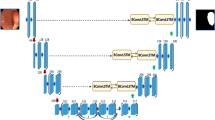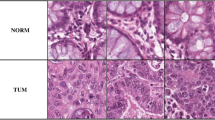Abstract
Developments in deep learning have resulted in computer-aided diagnosis for many types of cancer. Previously, pathologists manually performed the labeling work in the analysis of colon tissues, which is both time-consuming and labor-intensive. Results are easily affected by subjective conditions. Therefore, it is beneficial to identify the cancerous regions of colon cancer with the assistance of computer-aided technology. Pathological images are often difficult to process due to their irregularity, similarity between cancerous and non-cancerous tissues and large size. We propose a multi-scale perceptual field fusion structure based on a dilated convolutional network. Using this model, a structure of dilated convolution kernels with different aspect ratios is inserted, which can process cancerous regions of different sizes and generate larger receptive fields. Thus, the model can fuse detailed information at different scales for better semantic segmentation. Two different attention mechanisms are adopted to highlight the cancerous areas. A large, open-source dataset was used to verify improved efficacy when compared to previously disclosed methods.
Graphical abstract





Similar content being viewed by others
References
Moini J, Ahangari R, Miller C et al (2020) Obesity and cancer. Global Health Complications of Obesity. pp 109–145
Long J, Shelhamer E, Darrell T (2015) Fully convolutional networks for semantic segmentation[J]. IEEE Trans Pattern Anal Mach Intell 39(4):640–651
Chen LC, Papandreou G, Kokkinos I et al (2018) DeepLab: semantic image segmentation with deep convolutional nets, atrous convolution, and fully connected CRFs[J]. IEEE Trans Pattern Anal Mach Intell 40(4):834–848
Chen L C, Papandreou G, Schroff F et al (2017) Rethinking atrous convolution for semantic image segmentation[J]. arXiv preprint arXiv:1706.05587
Zhao H, Shi J, Qi X et al (2016) Pyramid scene parsing network. IEEE Computer Society, New Jersey
Peng C, Zhang X, Yu G et al (2017) Large kernel matters—improve semantic segmentation by global convolutional network[C]. In: Proceedings of the IEEE conference on computer vision and pattern recognition, pp 4353–4361
Bing S, Zhen Z, Wang B et al (2018) Scene segmentation with DAG-recurrent neural networks[J]. IEEE Trans Pattern Anal Mach Intell 40(6):1480–1493
Gers FA, Schmidhuber J et al (2000) Learning to forget: continual prediction with LSTM. Neural Comput 12:2451–2471
Zhao X, Wu Y, Song G et al (2017) A deep learning model integrating FCNNs and CRFs for brain tumor segmentation[J]. Med Image Anal 43:98–111
Liu LC, Tsai YH, Chou YC et al (2020) Concordance analysis of intrapartum cardiotocography between physicians and artificial intelligence (AI)-based technique using modified 1D fully convolutional networks (FCN). J Chin Medic Assoc 84:158–164
Zhu H, Adeli E, Shi F et al (2020) FCN based label correction for multi-atlas guided organ segmentation. Neuroinformatics 18(3):319–331
Yu F, Koltun V, Funkhouser T (2017) Dilated residual networks. IEEE Computer Society, New Jersey
Lin G, Shen C, Hengel A et al (2016) Efficient piecewise training of deep structured models for semantic segmentation. 2016 IEEE Conference on Computer Vision and Pattern Recognition (CVPR). IEEE, New Jersey
Liu S, Qi X, Shi J et al (2016) Multi-scale patch aggregation (MPA) for simultaneous detection and segmentation. 2016 IEEE Conference on Computer Vision and Pattern Recognition (CVPR). IEEE, New Jersey
Shuai B, Zuo Z, Wang G et al (2016) DAG-recurrent neural networks for scene labeling. IEEE, New Jersey
Wang B, Zhiqiang C et al (2019) U-net-based blocked artifacts removal method for dynamic computed tomography. Appl Opt 58(14):3748–3753
Volodymyr M, Nicolas H, Alex G et al (2014) Recurrent models of visual attention. Advances in neural information processing systems. pp 2204–2212
Lu J, Xiong C, Parikh D et al (2017) Knowing when to look: adaptive attention via a visual sentinel for image captioning. 2017 IEEE Conference on Computer Vision and Pattern Recognition (CVPR). IEEE, New Jersey
Oktay O, Schlemper J, Folgoc LL et al (2018) Attention u-net: learning where to look for the pancreas[J]. arXiv preprint arXiv:1804.03999
Zhou B, Khosla A, Lapedriza A et al (2016) Learning deep features for discriminative localization. CVPR IEEE Computer Society, New Jersey
Xu K, Ba J, Kiros R et al (2015) Show, attend and tell: neural image caption generation with visual attention. Comput Sci 2015:2048–2057
Hu J, Shen L, Sun G (2018) Squeeze-and-excitation networks[C]. In: Proceedings of the IEEE conference on computer vision and pattern recognition, pp 7132–7141
Wang X, Girshick R, Gupta A et al (2018) Non-local neural networks. 2018 IEEE/CVF Conference on Computer Vision and Pattern Recognition (CVPR). IEEE, New Jersey
Fu J, Liu J, Tian H et al (2020) Dual attention network for scene segmentation. 2019 IEEE/CVF Conference on Computer Vision and Pattern Recognition (CVPR). IEEE, New Jersey
Li X, Ding L, Li W et al (2017) FPGA accelerates deep residual learning for image recognition. 2017 IEEE 2nd Information Technology, Networking, Electronic and Automation Control Conference (ITNEC). IEEE, New Jersey
Chen L C, Collins M D, Zhu Y et al (2018) Searching for efficient multi-scale architectures for dense image prediction[J]. arXiv preprint arXiv:1809.04184
Milletari F, Navab N, Ahmadi SA (2016) V-Net: fully convolutional neural networks for volumetric medical image segmentation. 2016 Fourth International Conference on 3D Vision (3DV). IEEE, New Jersey
Funding
This work was supported in part by National Instrument Funds “Development and application of multidimensional biological tissue characterization and analysis instrument.”
Author information
Authors and Affiliations
Corresponding author
Additional information
Publisher’s note
Springer Nature remains neutral with regard to jurisdictional claims in published maps and institutional affiliations.
Rights and permissions
About this article
Cite this article
Cheng, H., Wu, K., Tian, J. et al. Colon tissue image segmentation with MWSI-NET. Med Biol Eng Comput 60, 727–737 (2022). https://doi.org/10.1007/s11517-022-02501-7
Received:
Accepted:
Published:
Issue Date:
DOI: https://doi.org/10.1007/s11517-022-02501-7




